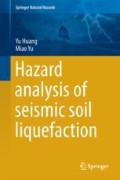Abstract
The previous chapters analyzed in detail and summarized the mechanism of seismic liquefaction potential. It is well known that the hazard of sand soil liquefaction is very serious. Field soil liquefaction damages structures. Therefore, this chapter introduces various evaluation methods of seismic liquefaction performance in geotechnical problems. Considering the randomness of the seismic ground motions, the dynamic reliability method is also introduced. Finally, a case study of actual engineering is carried out based on a performance-based seismic design concept (Priestley 2000).
Access this chapter
Tax calculation will be finalised at checkout
Purchases are for personal use only
References
Chen, J. B., & Li, J. (2007). Development-process-of-nonlinearity-based reliability evaluation of structures. Probabilistic Engineering Mechanics, 22(3), 267–275.
Chen, J. B., & Li, J. (2009). A note on the principle of preservation of probability and probability density evolution equation. Probabilistic Engineering Mechanics, 24(1), 51–59.
Chen, J. B., & Li, J. (2010). Stochastic seismic response analysis of structures exhibiting high nonlinearity. Computers & Structures, 88(7), 395–412.
Code for seismic design of buildings. (GB50011-2010). Ministry of housing and urban-rural of the People’s Republic of China (in Chinese).
Code for engineering geological investigation of water resources and hydropower. (GB50487-2008). General Administration of Quality Supervision, Inspection and Quarantine of the People’s Republic of China & Ministry of Housing and Urban-Rural Construction of the People’s Republic of China (in Chinese).
Hynes-Griffin, M. E., & Franklin, A. G. (1984). Rationalizing the seismic coefficient method (No. WES/MP/GL-84-13). Army Engineer Waterways Experiment Station Vicksburg Ms Geotechnical Lab.
Huang, Y., & Xiong, M. (2016). Probability density evolution method for seismic liquefaction performance analysis of earth dam. Earthquake Engineering and Structural Dynamics. doi:10.1002/eqe.2837
Huang, Y., Xiong, M., & Zhou, H. B. (2015). Ground seismic response analysis based on the probability density evolution method. Engineering Geology, 198, 30–39.
Iai, S., Matsunaga, Y., & Kameoka, T. (1990). Parameter identification for a cyclic mobility model. Report of the Port and harbour Research Institute, 29(4), 57–83.
Iai, S., & Ichii, K. (2010). Soils and foundations during earthquakes. Soils and Foundations, 50(6), 937–953.
Li, J., & Chen, J. B. (2008). The principle of preservation of probability and the generalized density evolution equation. Structural Safety, 30(1), 65–77.
Li, J., & Chen, J. B. (2009). Stochastic dynamics of structures. Singapore: Wiley.
Liu, Z. J., Liu, W., & Peng, Y. B. (2016). Random function based spectral representation of stationary and non-stationary stochastic processes. Probabilistic Engineering Mechanics, 45, 115–126.
Liu, Z. J., & Zeng, B. (2014). Aseismatic design code of hydraulic structures-based probabilistic model for non-stationary ground motion. China Civil Engineering Journal, S1 (in Chinese).
Priestley, M. J. N. (2000). Performance based seismic design. Bulletin of the New Zealand Society for Earthquake Engineering, 33(3), 325–346.
Shen, Z. J., Huang J. D., & Wang, Z. N. (1984). Analysis of liquefaction and deformation of double earth dam during Tangshan Earthquake. Hydro-Science and Engineering, 1, 52–61.
Standard, C. (2001). Specifications for seismic design of hydraulic structures. Beijing: Chinese Electric Power Press.
Seismic ground motion parameter zonation map of China. (GB18306-2001). General Administration of Quality Supervision, Inspection and Quarantine of the People’s Republic of China (in Chinese).
Wieland, M., & Brenner, R. P. (2008). Current seismic safety requirements for large dams and their implication on existing dams. Proceedings International Symposium on Operation, Rehabilitation and Upgrading of Dams, 76th Annual ICOLD Meeting (pp. 1–10). Bulgaria: Sofia.
Author information
Authors and Affiliations
Corresponding author
Rights and permissions
Copyright information
© 2017 Springer Nature Singapore Pte Ltd.
About this chapter
Cite this chapter
Huang, Y., Yu, M. (2017). Comprehensive Evaluation of Liquefaction Damage During Earthquakes. In: Hazard Analysis of Seismic Soil Liquefaction. Springer Natural Hazards. Springer, Singapore. https://doi.org/10.1007/978-981-10-4379-6_7
Download citation
DOI: https://doi.org/10.1007/978-981-10-4379-6_7
Published:
Publisher Name: Springer, Singapore
Print ISBN: 978-981-10-4378-9
Online ISBN: 978-981-10-4379-6
eBook Packages: Earth and Environmental ScienceEarth and Environmental Science (R0)

